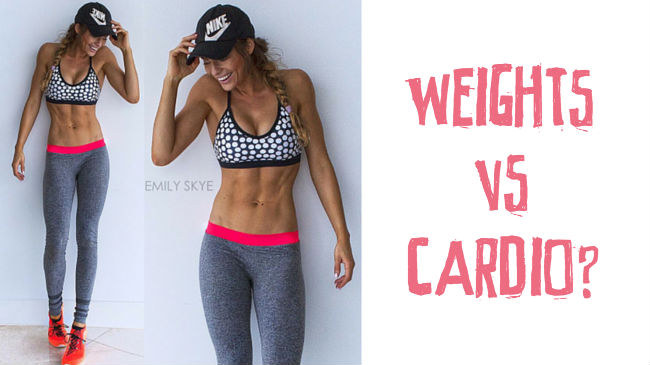Is Cardio Really the Secret to Fat Loss
One of the most talked about subjects in the fitness industry is this: Cardio and fat loss.
Here’s what your clients (and yes, even us trainers too) want to know:
Is cardio really necessary for fat loss?
Which type of cardio will optimize fat loss? LISS (low intensity steady state cardio) or HIIT (high intensity interval training)?
The good news is that there is some pretty clear research that can answer these questions. First, let’s take a look at what cardio actually is and what the different types do for your body.
Aerobic vs. Anaerobic Training
There are two basic types of physical training: aerobic and anaerobic. To understand how our bodies lose fat during training, and to be better able to explain it to your clients, you need to know what these terms really mean, technically and practically.
- Aerobic activity. Aerobic training requires the presence of oxygen. It is the type of activity that primarily works type I muscle fibers. This helps to increase muscle endurance and capillary size, and generally helps the heart muscle to pump blood more efficiently. Aerobic activity is done at a pace you can sustain for an extended period of time; think 50 to 70 percent of VO2max and a heart rate between 120 and 150 BPM: lower intensity jogging, swimming, or biking, for example.
- Anaerobic activity. This is just the opposite of aerobic activity. Anaerobic training is exercise that does not require the presence of oxygen. It works the type II muscle fibers, which leads to greater size and strength of muscles. Sprinting until you gas out or resistance training with heavy weights is anaerobic. When you work at 90, to well over 100 percent of your VO2 max performinganaerobic activity, oxygen builds up, lactic acid builds up, and you start to feel the burn.1 You can’t sustain this kind of activity for extended time periods like you can with aerobic exercise.
LISS, low intensity steady state cardio is aerobic activity, while HIIT, high intensityinterval training, is anaerobic. Before we answer the question of which is better, why do cardio at all?
Important Question #1:
Do You Really Need to Do Cardio to Lose Fat?
The quick answer is no. You do not need to do cardio exercise to lose fat. You can lose fat by restricting caloric intake, by doing resistance training, or by a combination of both.
The main factor in losing body fat is taking in fewer calories than you expend. Cardio can help you expend more calories, but is not absolutely necessary.
Restricting caloric intake is an obvious solution to fat loss. If you consume fewer calories, you will burn and lose more fat. But, what about resistance training? How does that help with fat loss?
Resistance training is one of the best ways to get lean because it builds muscle.2 When you add muscle, you raise your resting energy expenditure (the amount of calories you burn when you’re just sitting still).
Muscle tissue requires more calories to function, even at rest, than fat tissue. The more muscle mass you have, the more calories you burn per day.
Important Question #2:
Which Type of Cardio Maximizes Fat Loss?
Just because cardio isn’t necessary for fat loss doesn’t mean you shouldn’t do it. Cardio has other benefits, especially for health, and can contribute to your calorie deficit. So, which is better, aerobic LISS or anaerobic HIIT?
A traditional outlook on cardio and fat loss is that a good, long, low intensity workout on an empty stomach will lead to the greatest fat loss. A long, slow run first thing in the morning is the go-to daily workout for a lot of people.
Views on this are changing, though, with research to back it up. What the current research tells us is that HIIT is a powerful way to lose fat, as compared to LISS training. Lower intensity aerobic cardio leads to less fat loss and may even hinder muscle growth, when compared to HIIT workouts.3
For example, one study found that fat oxidation, the use of fat molecules for energy, was significantly higher after six weeks of interval training.4 Carbohydrate oxidation, the use of sugar for energy, was lower. In other words, HIIT caused the body to target fat stores for energy, which means greater fat loss.
In another study, researchers compared individuals doing LISS for several weeks to those doing HIIT over the same time period. Fat loss in the HIIT group was up to nine times greater than in the LISS group.1
One reason that may help explain the greater fat loss experienced with HIIT is that this type of exercise may increase EPOC, excess post-exercise oxygen consumption.1 After a HIIT session, you continue to oxidize fat, more so than after a LISS workout.
Researchers have also found that HIIT workouts can increase the levels of growth hormone in the body, which also may contribute to fat loss.5
The Bottom Line…
There is a time and a place for all types of exercise and both types of cardio. Both aerobic and anaerobic training provide a lot of benefits. The definitive answer, for now, is that HIIT is the front-runner when it comes to burning fat.
So, if your client’s number one goal is to lose weight, focus on HIIT, but don’t leave out other types of training. Also, remember that if your client is classified as a beginner, HIIT may not be the right method of training right out of the gate. They may need time to work up to a fitness level where they feel comfortable enough to start performing interval workouts. Resistance training builds muscle and leads to higher resting energy expenditure.


No Comments